 |
MURPHY B485 - U.K. - 1961 |
 |
 Description
Description Restoration
Restoration |
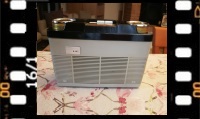 |
 Descrizione
Descrizione Restauro
Restauro |
|
|
|
|||
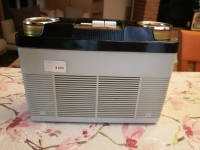 |
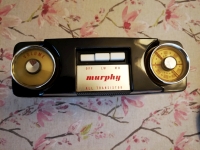 |
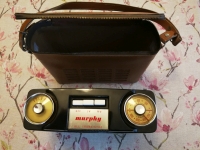 |
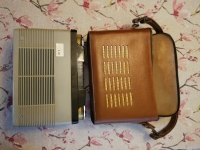 |
 The Murphy B485 is a portable transistor radio with Long and Medium Wave
reception, built by Murphy Radio Ltd. Welwyn Garden City (United
Kingdom) in 1961. The B485 was the version for portable use only of the
B385 that could be inserted in an amplified loudspeaker box, and of
which it used the same electrical scheme with few modifications to the
antenna circuit and power supply.
The Murphy B485 is a portable transistor radio with Long and Medium Wave
reception, built by Murphy Radio Ltd. Welwyn Garden City (United
Kingdom) in 1961. The B485 was the version for portable use only of the
B385 that could be inserted in an amplified loudspeaker box, and of
which it used the same electrical scheme with few modifications to the
antenna circuit and power supply.By 1961 the use of transistors in portable radios was well established and the Japanese were invading the world market with their miniaturized pocket devices. But in old Europe the mini components necessary for such miniature marvels were not yet available, as well as the printed circuits, necessary to rationalize the assembly of small parts. The Murphy in fact still used a heavy metal frame where the discrete components were arranged around it, connected by long wires in apparent disorder. Despite this, the radio worked well and thanks to the generous Celestion loudspeaker, the acoustic performance was excellent. The radio cabinet is made of two-tone plastic with two large knobs placed in the upper part: the volume control on the left and the geared tuning control on the right. In the middle between the two knobs there is a push-button panel with three large white keys: the ignition, the Long Wave selector and the Medium Wave selector. On the back of the cabinet there is an antenna socket that can be connected with a car-type plug. The radio was sold complete with a beautiful leather bag with carrying strap and zip closure. The dimensions of the radio are: 9.64 x 7 x 3.158 in (W, H, D) and the weight is 3.3 lb. The electrical circuit is a superheterodyne with IF at 470 KHz which initially used seven germanium transistors from Ediswan, Siemens Edison Swan Electric Co. London: 2 x PXA102, 2 x PXA101, PXB103 and 2 x PXC131. Later the Ediswan transistors were replaced by Mullard equivalents: 2 x OC44, 2×OC45, OC81D and 2× OC81 in the BF audio stage. The antenna used is internal, a coil wrapped around a long ferroxcube core, therefore, in order to receive the signal correctly, the device must be oriented at right angles to the broadcasting station. Originally the radio was powered by two 6 V PP1 type batteries which allowed a long operating autonomy and a moderate sound volume reproduced by the excellent 12.7 cm (5 inch) Celestion loudspeaker. The sensitivity and selectivity in reception are excellent thanks to the High Frequency amplifier stage and the subsequent two Intermediate Frequency stages. Like other English transistor devices built in the late fifties and early sixties, compared to the Regency TR1, the first transistor receiver built by Texas Instruments U.S.A., the dimensions and weight of the Murphy were considerable. However, the size was counterbalanced by a pleasant and full-bodied sound reproduction and by the long autonomy of the batteries. During the day the Medium and Long Wave bands are almost deserted, European Broadcasting transmissions are now all in FM in the VHF band (88-108 MHz) and are about to migrate to the DAB+ (Digital Audio Broadcasting) digital system which works in VHF III ( 174-230MHz). The exceptions are a few weak private broadcasters who courageously took the place of the state broadcasters in the Medium Waves. In the evening and at night things improve somewhat, many signals still come out of the receiver loudspeaker which thanks to propagation arrive in my area from every corner of Europe, Africa and Asia. © IK3HIA - 2022. |
|||
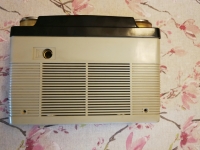 |
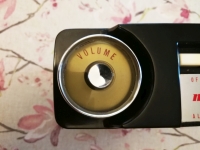 |
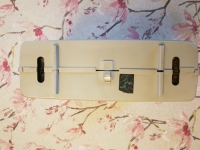 |
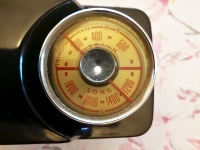 |
|
Return to top of page
|
|||
| Descrizione | |||
 La Murphy B485 è una radio portatile a transistor con ricezione in Onde
Lunghe e Medie, costruita dalla Murphy Radio Ltd. Welwyn Garden City
(Regno Unito) nel 1961. La B485 era la versione per il solo uso
portatile della B385 che invece poteva essere inserita in una cassa
acustica amplificata. I due modelli utilizzavano lo stesso schema
elettrico con poche modifiche al circuito dell'antenna e ai collegamenti
dell'alimentazione.
La Murphy B485 è una radio portatile a transistor con ricezione in Onde
Lunghe e Medie, costruita dalla Murphy Radio Ltd. Welwyn Garden City
(Regno Unito) nel 1961. La B485 era la versione per il solo uso
portatile della B385 che invece poteva essere inserita in una cassa
acustica amplificata. I due modelli utilizzavano lo stesso schema
elettrico con poche modifiche al circuito dell'antenna e ai collegamenti
dell'alimentazione.Nel 1961 l'utilizzo dei transistor nelle radio portatili era ormai consolidato e i giapponesi stavano invadendo il mercato mondiale con i loro apparecchi tascabili miniaturizzati. Ma nella vecchia Europa i mini componenti necessari per tali meraviglie in miniatura non erano ancora disponibili, come pure i circuiti stampati, necessari per razionalizzare il montaggio delle piccole parti. La Murphy infatti utilizzava ancora un pesante telaio metallico dove i componenti discreti erano disposti all'intorno, collegati da lunghi fili in apparente disordine. Non ostante ciò la radio funzionava bene e grazie al generoso altoparlante della Celestion la resa acustica era ottima. Il mobiletto della radio è realizzato in plastica bicolore con due ampie manopole poste nella parte superiore: il controllo del volume a sinistra e il comando di sintonia demoltiplicata a destra. Nel mezzo tra le due manopole c'è una pulsantiera con tre larghi tasti bianchi: l'accensione, il selettore delle Onde Lunghe e il selettore delle Onde Medie. Nella parte posteriore del mobile è presente una presa d'antenna collegabile con spinotto tipo auto. La radio veniva venduta completa di una bella borsa in cuoio dotata di cinghia per il trasporto e chiusura zip. Le dimensioni della radio sono: 24.6 x 18 x 8 cm (L, A, P) e il peso è di 1.85 Kg. Il circuito elettrico è una supereterodina con Frequenza Intermedia a 470 KHz che inizialmente utilizzava sette transistor al germanio della Ediswan, Siemens Edison Swan Electric Co. London: 2 x PXA102, 2 x PXA101, PXB103 e 2 x PXC131. Successivamente i transistor Ediswan sono stati sostituiti dagli equivalenti della Mullard: 2 x OC44, 2 ×OC45, OC81D e 2× OC81 nello stadio audio a BF. L'antenna utilizzata è interna, una bobina avvolta su un lungo nucleo ferroxcube, pertanto per ricevere il segnale in modo corretto bisogna orientare l'apparecchio in posizione ortogonale alla stazione emittente. A suo tempo la radio veniva alimentata da due batterie tipo PP1 da 6 V cadauna che permettevano una lunga autonomia di esercizio e un discreto volume sonoro riprodotto dall'ottimo altoparlante Celestion da 12.7 cm (5 pollici). La sensibilità e la selettività in ricezione sono ottime per merito dello stadio amplificatore in Alta Frequenza e dei successivi due stadi di Frequenza Intermedia. Come altri apparecchi a transistor inglesi costruiti a fine anni cinquanta e inizio anni sessanta, rispetto al Regency TR1, il primo ricevitore a transistor costruito dalla Texas Instruments U.S.A., le dimensioni e il peso del Murphy erano ragguardevoli. L'ingombro però era controbilanciato da una riproduzione sonora gradevole e corposa e dalla lunga autonomia delle batterie. Di giorno le bande delle Onde Medie e Lunghe sono pressoché deserte, le trasmissioni Broadcasting Europee sono ormai tutte in FM nella banda VHF (88-108 MHz) e anzi stanno per migrare nel sistema digitale DAB+ (Digital Audio Broadcasting) che lavora in VHF III (174-230 MHz). Fanno eccezione poche e deboli emittenti private che nelle Onde Medie hanno coraggiosamente preso il posto di quelle statali. Di sera e di notte le cose migliorano alquanto, dall'altoparlante del ricevitore escono ancora molti segnali che grazie alla propagazione arrivano nella mia zona da ogni angolo dell'Europa, dell'Africa e dell'Asia. © IK3HIA - 2022. |
|||
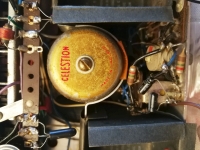 |
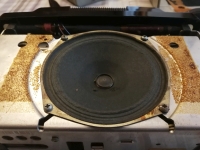 |
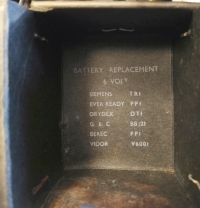 |
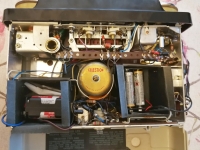 |
|
Return to top of page
|
|||
| Restoration | |||
 I purchased the radio through an online
auction where it was defined as working. When the B485 arrived I
couldn't wait in applying immediately the dual power supply to the
appropriate contacts. The Murphy actually worked perfectly, the seller
had told no lies.
I purchased the radio through an online
auction where it was defined as working. When the B485 arrived I
couldn't wait in applying immediately the dual power supply to the
appropriate contacts. The Murphy actually worked perfectly, the seller
had told no lies.Turning off the radio and opening the rear and front shells, I immediately noticed that expert technical hands had made some repairs. All the electrolytic capacitors had been replaced with modern items and so had two transistors. The TR2 (OC44) and the TR3 (OC45) had been replaced by two BC557. The radio worked perfectly but two germanium transistors was replaced with two silicon PNPs which went into production in the first half of the 1970s. The Murphy was a noble radio and deserved to have its original semiconductors returned. So I did a quick search on the internet and on the usual auction site I found two Philips items at a reasonable price. I know, they weren't the Mullard originals which were actually also for sale but at too hight cost, so with a quick decision I ordered two pairs (melius est abundare quam deficere). The Philips transistors arrived after a week and with due precautions I eliminated the BC557s and soldered the "new" OC44 and OC45 in the circuit, respecting their polarities and keeping the terminals cool with the special elastic steel tweezers. Turning again the radio on, I was pleased to hear that the set was still working. Since the receiver was open and since I had replaced two of the active elements, I took advantage of it to carry out the calibrations as recommended in the 1963 "Trader" Service Sheet N. 1585 of which I had recovered a copy immediately after the purchase. The Intermediate Frequency stages really needed calibration because, after connecting the 470 KHz modulated generator and carefully adjusting the cores of the coils, the output signal from the loudspeaker became somewhat robust. After disconnecting the generator in power off, I turned the device back on and tuned it to Medium Waves. I don't know if thanks to the germanium semiconductors or to the calibration, now the radio worked better than before and the signal of a private station that broadcasts on the frequency of 1 Mhz about 24 miles away from my house came loud and clear. Before locking up the cabinet shells, I took the opportunity to use the contact cleaner spray on the push-button panel and on the volume potentiometer. To finish the job I unsoldered the pressure contacts of the old PP1 batteries by now absolutely unobtainable and in their place I connected the respective contacts of two 4 x AA (LR6) battery holders each of which supplies the necessary 6 V. I didn't throw away the old button contacts, but I placed them in a bag inside the radio, you never know that sooner or later I'll find a couple of exhausted PP1 batteries in which I can replace the original elements with alkaline cells or rechargeable lithium cells. At this point the restoration of the old Murphy B485 could be considered completed and to seal the success I recorded a short video of the radio working. © IK3HIA - 2022. |
|||
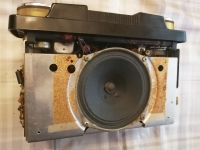 |
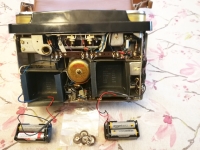 |
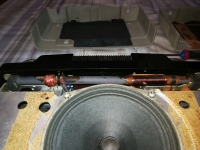 |
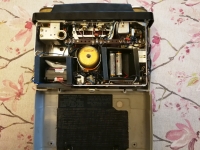 |
|
Return to top of page
|
|||
| Restauro | |||
 Ho acquistato la radio tramite un'asta on line dove era stata definita
come funzionante. Qando la B485 mi è arrivata non ho saputo trattenermi
dall'applicare subito la doppia alimentazione agli appositi contatti.
La Murphy in effetti funzionava perfettamente, il venditore non aveva
raccontato bugie.
Ho acquistato la radio tramite un'asta on line dove era stata definita
come funzionante. Qando la B485 mi è arrivata non ho saputo trattenermi
dall'applicare subito la doppia alimentazione agli appositi contatti.
La Murphy in effetti funzionava perfettamente, il venditore non aveva
raccontato bugie.Spenta la radio e aperti i gusci posteriore e anteriore ho subito notato che mani tecniche esperte avevano effettuato alcune riparazioni. Tutti i condensatori elettrolitici erano stati sostituiti con materiale moderno e così pure era stato fatto con due transistor. Il TR2 (OC44) e il TR3 (OC45) erano stati sostituito da due BC557. La radio funzionava perfettamente ma due transistor al germanio erano stati sostituiti con due PNP al silicio entrati in produzione nella prima metà degli anni '70. La Murphy era una radio di pregio e meritava che le fossero restituiti i semiconduttori originali. Così ho effettuato una rapida ricerca su internet e sul solito sito di aste ho trovato due elementi della Philips a un prezzo ragionevole. Oibò, non erano gli originali della Mullard che in effetti c'erano anche ma che costavano troppo, e con una rapida decisione ne ho ordinato due coppie (melius est abundare quam deficere). I transistor Philips sono arrivati dopo una settimana e con le debite precauzioni ho eliminato i BC557 e saldato i "nuovi" OC44 e OC45 nel circuito rispettandone le polarità e tenendo i terminali raffreddati con l'apposita pinzetta elastica d'acciaio. Riaccesa la radio ho avuto il piacere di constatare che l'apparecchio funzionava ancora. Già che il ricevitore era aperto e visto che avevo sostituito due degli elementi attivi, ne ho approfittato per effettuare le tarature come consigliato nel "Trader" Service Sheet N. 1585 del 1963 di cui subito dopo l'acquisto avevo recuperato una copia. Gli stadi di Frequenza Intermedia avevano davvero bisogno di taratura perché dopo aver collegato il generatore modulato a 470 KHz e regolato con cautela i nuclei delle bobine il segnale in uscita dall'altoparlante si è irrobustito alquanto. Scollegato il generatore ho riacceso l'apparecchio l'ho sintonizzato sulle Onde Medie. Non so se per merito dei semiconduttori al germanio o dalla taratura, adesso la radio funzionava meglio di prima e il segnale di una stazione privata che trasmette sui 300 metri da una quarantina di Km di distanza da casa mia arrivava forte e chiaro. Prima di rinchiudere i gusci del mobiletto ho colto l'occasione per usare lo spray pulisci contatti sulla pulsantiera e nel potenziometro del volume. Per terminare il lavoro ho dissaldato i contatti a pressione delle vecchie batterie PP1 ormai assolutamente introvabili e al loro posto ho collegato i rispettivi contatti di due portabatterie da 4 x AA (LR6) ognuno dei quali fornisce i 6 V necessari. I vecchi contatti a bottone non li ho buttati, ma li ho riposti in una bustina dentro la radio, non si sa mai che prima o poi mi capiti di rintracciare un paio di batterie PP1 esaurite nelle quali poter sostituire gli elementi originali con delle celle al litio ricaricabili. A questo punto il ripristino della vecchia Murphy B485 poteva considerarsi concluso e per suggellarne il buon successo ho registrato un breve video della radio in funzione. © IK3HIA - 2022. |
|||
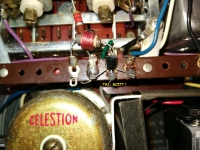 |
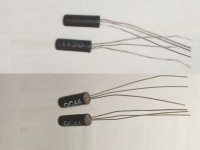 |
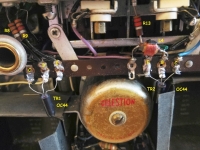 |
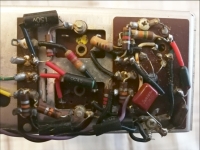 |
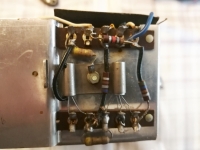 |
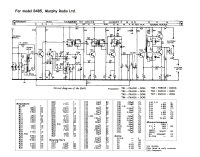 |
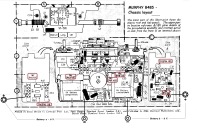 |
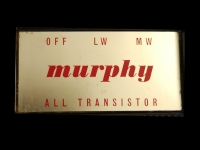 |
|
Return to top of page
|
|||
|
|
Return to: IK3HIA home page |
|
Return to: Transistor Radio |
|
Go to: Transistor diagrams |